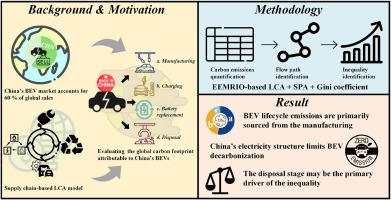Unveiling the inequality and embodied carbon emissions of China's battery electric vehicles across life cycles by using a MRIO-based LCA model
IF 6.3
2区 工程技术
Q1 ECONOMICS
引用次数: 0
Abstract
China dominates the battery electric vehicle (BEV) market, contributing 60 % of global sales. However, the rapid expansion of BEV has raised global carbon emissions through supply chains. This study adopted the Multi-Regional Input-Output-based Life-Cycle Assessment (MRIO-based LCA) model to evaluate the embodied carbon emissions across all BEV life cycle stages, including manufacturing, driving, battery replacing, and scrapping phases. Furthermore, the Gini coefficient was adopted to reveal the inequality of global carbon emissions induced by each life cycle stage of BEV in China. The results indicate that BEV generated 101 million tons of carbon emissions, with manufacturing phase accounting for 53 %. The scrapping stage is indicated as the main driver of global carbon emission inequality across the BEV life cycle. While BEV eliminate tailpipe emissions, their “zero-emission” potential remains constrained by decarbonization of power supply. Findings provide a scientific basis for formulating equitable emission reduction policies.

利用基于mrio的LCA模型揭示中国电动汽车全生命周期的不平等和隐含碳排放
中国主导着纯电动汽车(BEV)市场,占全球销量的60%。然而,纯电动汽车的快速扩张通过供应链增加了全球碳排放。本研究采用基于多区域投入产出的生命周期评估(Multi-Regional Input-Output-based life cycle Assessment, MRIO-based LCA)模型,对纯电动汽车制造、行驶、电池更换和报废等全生命周期阶段的隐含碳排放进行了评估。进一步,采用基尼系数揭示了中国纯电动汽车各生命周期阶段全球碳排放的不平等。结果表明,纯电动汽车产生的碳排放量为1.01亿吨,其中制造阶段占53%。报废阶段是整个纯电动汽车生命周期全球碳排放不平等的主要驱动因素。虽然纯电动汽车消除了尾气排放,但其“零排放”潜力仍受到电力供应脱碳的限制。研究结果为制定公平的减排政策提供了科学依据。
本文章由计算机程序翻译,如有差异,请以英文原文为准。
求助全文
约1分钟内获得全文
求助全文
来源期刊

Transport Policy
Multiple-
CiteScore
12.10
自引率
10.30%
发文量
282
期刊介绍:
Transport Policy is an international journal aimed at bridging the gap between theory and practice in transport. Its subject areas reflect the concerns of policymakers in government, industry, voluntary organisations and the public at large, providing independent, original and rigorous analysis to understand how policy decisions have been taken, monitor their effects, and suggest how they may be improved. The journal treats the transport sector comprehensively, and in the context of other sectors including energy, housing, industry and planning. All modes are covered: land, sea and air; road and rail; public and private; motorised and non-motorised; passenger and freight.
 求助内容:
求助内容: 应助结果提醒方式:
应助结果提醒方式:


